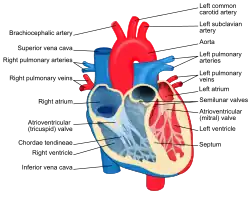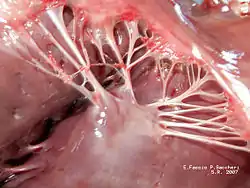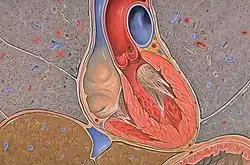Chordae tendineae
The chordae tendineae (SG: chorda tendinea) or tendinous cords, colloquially known as the heart strings, are inelastic cords of fibrous connective tissue that connect the papillary muscles to the tricuspid valve and the mitral valve in the heart.[1][2]
| Chordae tendineae | |
|---|---|
 The chordae tendineae connect the valves to the heart muscle | |
 Papillary muscles and chordae tendineae | |
| Details | |
| Identifiers | |
| Latin | chordae tendineae cordis |
| MeSH | D002815 |
| TA98 | A12.1.00.023 |
| TA2 | 4047, 4069 |
| FMA | 76527 |
| Anatomical terminology | |
Structure
The chordae tendineae connect the atrioventricular valves (tricuspid and mitral), to the papillary muscles within the ventricles.[2] Multiple chordae tendineae attach to each leaflet or cusp of the valves.[3] Chordae tendineae contain elastin in a delicate structure notably at their periphery.[4]
Tendon of Todaro
The tendon of Todaro is a continuation of the Eustachian valve of the inferior vena cava and the valve of the coronary sinus. Along with the opening of the coronary sinus and the septal cusp of the tricuspid valve, it makes up Koch's triangle. The apex of Koch's triangle is the location of the atrioventricular node.[5]
Function

During atrial systole, blood flows from the atria to the ventricles down the pressure gradient. Chordae tendineae are relaxed because the atrioventricular valves are forced open.[6]
When the ventricles of the heart contract in ventricular systole, the increased blood pressures in both chambers push the AV valves to close simultaneously, preventing backflow of blood into the atria. Since the blood pressure in atria is much lower than that in the ventricles, the flaps attempt to evert to the low pressure regions. The chordae tendineae prevent this prolapse by becoming tense, which pulls on the flaps, holding them in closed position.[6]
Clinical significance
Ruptured chordae tendineae
Valvular heart disease can lead to ruptured chordae tendineae.[7] This can cause severe mitral insufficiency.[7][8]
Parachute mitral valve
Parachute mitral valve occurs when all the chordae tendineae of the mitral valve attach to a single papillary muscle.[9][10][11] This causes mitral valve stenosis at an early age.[10] It is a rare congenital heart defect.[11] Although it often causes mitral insufficiency, it may not present any symptoms.[10]
Additional images
 Papillary muscles and chordae tendineae
Papillary muscles and chordae tendineae- Ultrasound showing redundant chordae tendineae[12]
See also
References
- Hacking, Craig. "Chordae tendineae | Radiology Reference Article | Radiopaedia.org". Radiopaedia.
- Faletra, Francesco F.; Narula, Jagat (2017-01-01), Ellenbogen, Kenneth A.; Wilkoff, Bruce L.; Kay, G. Neal; Lau, Chu-Pak (eds.), "2 - Imaging of Cardiac Anatomy", Clinical Cardiac Pacing, Defibrillation and Resynchronization Therapy (Fifth Edition), Elsevier, pp. 15–60, doi:10.1016/b978-0-323-37804-8.00002-x, ISBN 978-0-323-37804-8, retrieved 2020-11-25
- Lane, Rondall; Schulman, Peter M. (2007-01-01), Parsons, Polly E.; Wiener-Kronish, Jeanine P. (eds.), "Chapter 30 - Valvular Heart Disease", Critical Care Secrets (Fourth Edition), Philadelphia: Mosby, pp. 191–199, doi:10.1016/b978-1-4160-3206-9.10030-8, ISBN 978-1-4160-3206-9, retrieved 2020-11-25
- Green, EM; Mansfield, JC; Bell, JS; Winlove, CP (2014-04-06). "The structure and micromechanics of elastic tissue". Interface Focus. 4 (2): 20130058. doi:10.1098/rsfs.2013.0058. PMC 3982448. PMID 24748954.
- McGuire, Mark A.; Johnson, David C.; Robotin, Monica; Richards, David A.; Uther, John B.; Ross, David L. (1992-09-15). "Dimensions of the triangle of Koch in humans". The American Journal of Cardiology. 70 (7): 829–830. doi:10.1016/0002-9149(92)90574-I. ISSN 0002-9149. PMID 1519544.
- Karas, S.; Elkins, R. C. (1970). "Mechanism of Function of the Mitral Valve Leaflets, Chordae Tendineae and Left Ventricular Papillary Muscles in Dogs". Circulation Research. 26 (6): 689–96. doi:10.1161/01.RES.26.6.689. PMID 5422929.
- Vaideeswar, P.; Butany, J. (2016-01-01), Buja, L. Maximilian; Butany, Jagdish (eds.), "Chapter 12 - Valvular Heart Disease", Cardiovascular Pathology (Fourth Edition), San Diego: Academic Press, pp. 485–528, ISBN 978-0-12-420219-1, retrieved 2020-11-25
- Reece, T. Brett; Fullerton, David A. (2009-01-01), Harken, Alden H.; Moore, Ernest E. (eds.), "Chapter 76 - Mitral Regurgitation", Abernathy's Surgical Secrets (Sixth Edition), Philadelphia: Mosby, pp. 387–390, doi:10.1016/b978-0-323-05711-0.00076-8, ISBN 978-0-323-05711-0, retrieved 2020-11-25
- Llewelyn, Rhys. "Parachute mitral valve | Radiology Reference Article | Radiopaedia.org". Radiopaedia.
- Boutsikou, Maria; Li, Wei (2018-01-01), Gatzoulis, Michael A.; Webb, Gary D.; Daubeney, Piers E. F. (eds.), "6 - Echocardiography", Diagnosis and Management of Adult Congenital Heart Disease (Third Edition), Elsevier, pp. 41–76, doi:10.1016/b978-0-7020-6929-1.00006-x, ISBN 978-0-7020-6929-1, retrieved 2020-11-25
- Tay Lik Wui, Edgar; Yip, James W. L.; Li, Wei (2011-01-01), Gatzoulis, Michael A.; Webb, Gary D.; Daubeney, Piers E. F. (eds.), "5 - Echocardiography", Diagnosis and Management of Adult Congenital Heart Disease (Second Edition), Saint Louis: Churchill Livingstone, pp. 28–43, doi:10.1016/b978-0-7020-3426-8.00005-8, ISBN 978-0-7020-3426-8, retrieved 2020-11-25
- "UOTW #75 - Ultrasound of the Week". Ultrasound of the Week. 4 November 2016. Retrieved 27 May 2017.